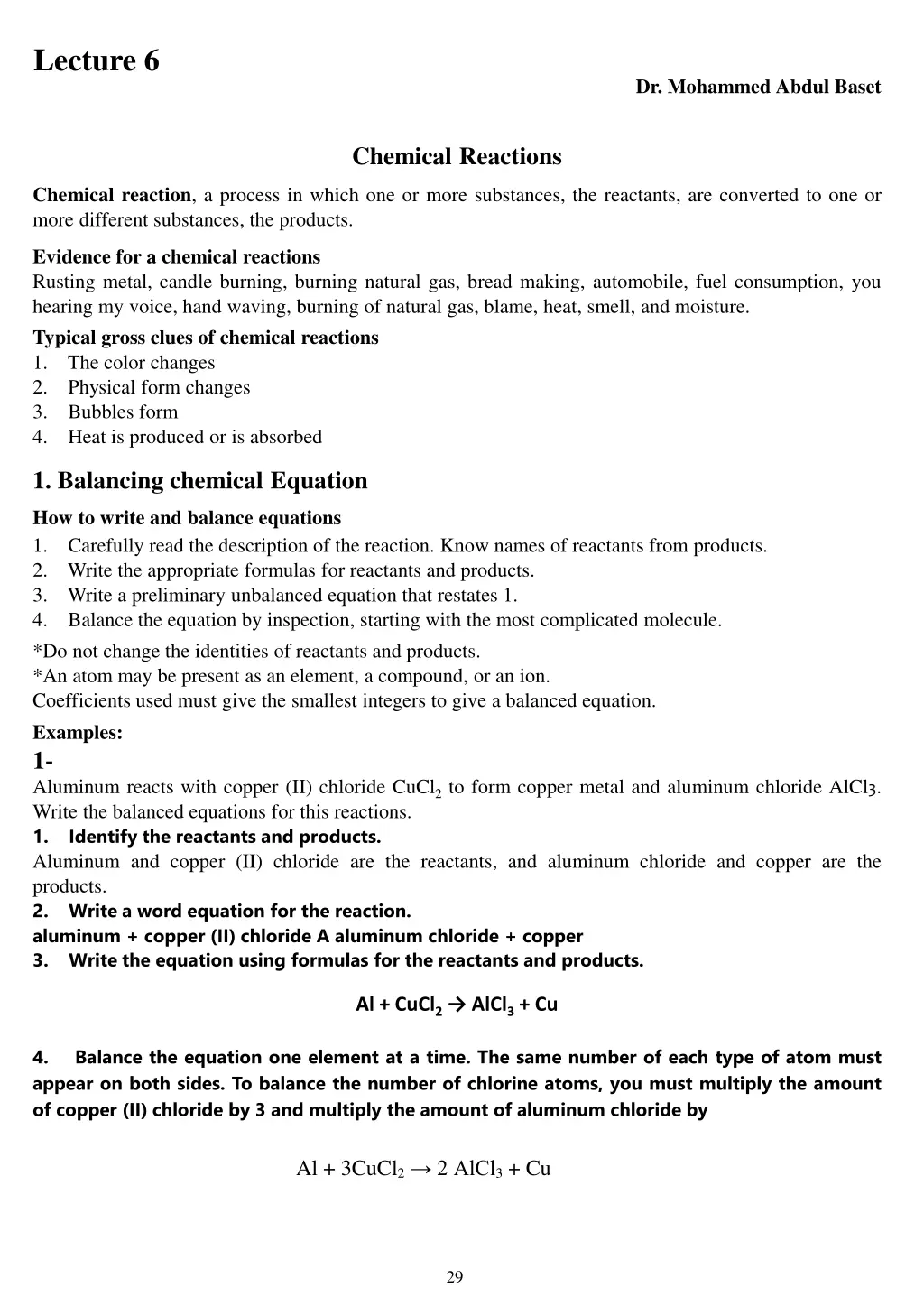
Chemical Reactions Overview & Balancing Equations
Explore the fundamentals of chemical reactions, learn how to balance chemical equations, and understand the different types of reactions including direct union, decomposition, and single replacement. Witness the evidence, clues, and steps involved in chemical reactions.
Download Presentation

Please find below an Image/Link to download the presentation.
The content on the website is provided AS IS for your information and personal use only. It may not be sold, licensed, or shared on other websites without obtaining consent from the author. If you encounter any issues during the download, it is possible that the publisher has removed the file from their server.
You are allowed to download the files provided on this website for personal or commercial use, subject to the condition that they are used lawfully. All files are the property of their respective owners.
The content on the website is provided AS IS for your information and personal use only. It may not be sold, licensed, or shared on other websites without obtaining consent from the author.
E N D
Presentation Transcript
Lecture 6 Dr. Mohammed Abdul Baset Chemical Reactions Chemical reaction, a process in which one or more substances, the reactants, are converted to one or more different substances, the products. Evidence for a chemical reactions Rusting metal, candle burning, burning natural gas, bread making, automobile, fuel consumption, you hearing my voice, hand waving, burning of natural gas, blame, heat, smell, and moisture. Typical gross clues of chemical reactions 1. The color changes 2. Physical form changes 3. Bubbles form 4. Heat is produced or is absorbed 1. Balancing chemical Equation How to write and balance equations 1. Carefully read the description of the reaction. Know names of reactants from products. 2. Write the appropriate formulas for reactants and products. 3. Write a preliminary unbalanced equation that restates 1. 4. Balance the equation by inspection, starting with the most complicated molecule. *Do not change the identities of reactants and products. *An atom may be present as an element, a compound, or an ion. Coefficients used must give the smallest integers to give a balanced equation. Examples: 1- Aluminum reacts with copper (II) chloride CuCl2 to form copper metal and aluminum chloride AlCl3. Write the balanced equations for this reactions. 1. Identify the reactants and products. Aluminum and copper (II) chloride are the reactants, and aluminum chloride and copper are the products. 2. Write a word equation for the reaction. aluminum + copper (II) chloride A aluminum chloride + copper 3. Write the equation using formulas for the reactants and products. Al + CuCl2 AlCl3+ Cu 4. Balance the equation one element at a time. The same number of each type of atom must appear on both sides. To balance the number of chlorine atoms, you must multiply the amount of copper (II) chloride by 3 and multiply the amount of aluminum chloride by Al + 3CuCl2 2 AlCl3 + Cu 29
To balance the equation, multiply the amount of copper produced by 3. 2Al +3CuCl2 2AlCl3 + 3 Cu 2- 2. Types of chemical reactions Most inorganic reactions can be classified into one of five general categories: direct union or combination, decomposition, displacement, metathesis or double displacement, and combustion reactions. Each of these will be discussed in more detail in the following: 30
1. Direct Union or Combination Reactions Any reaction in which two or more substances combine to form a single product is a direct union or combination reaction. The general form of a direct union reaction is A + B AB This type of reaction generally takes place between the following types of compounds: a. A metal + non-metal 2 Na + Cl2 2 NaCl sodium chloride Fe + S FeS iron(II) sulfide b. Metal oxide + non-metal oxide K2O + SO3 K2SO4 potassium sulfur potassium oxide trioxide sulfate CaO + CO2 CaCO3 calcium carbon calcium oxide dioxide carbonate c. Non-metal + non-metal C + O2 CO2 carbon dioxide N2 + 3 Cl2 2 NCI3 nitrogen trichloride 2. Decomposition Reactions In a decomposition reaction a compound is broken down into smaller compounds or separate elements. A decomposition reaction is the reverse of a synthesis reaction. The general form for a decomposition reaction is: AB A + B Some examples of decomposition reactions are: 31
2 KCIO3 2 KCl + 3 O2 potassium potassium chlorate chloride CaCOs CaO + CO2 calcium calcium carbon carbonate oxide dioxide 3. Single Replacement Reactions (Substitution) A single replacement involves an element reacting with a compound whereby the element displaces a second element from the compound. The general form of this type reaction is: A + BC AC + B Single replacement reactions usually occur between the following combinations: a. An active metal + an acid When a metal which is above hydrogen in the activity series is reacted with an acid, hydrogen is liberated and a salt is formed. Zn + 2 HCl ZnCl2 + H2 hydrochloric zinc acid chloride Mg + H2SO4 MgSO4 + H2 sulfuric magnesium acid sulfate b. A metal + a salt Each metal in the activity series displaces any metals below it to form a salt in solution. Cu + 2AgNO3 Cu(NO3)2 + 2 Ag silver copper(II) nitrate nitrate Fe + CuSO4 FeSO4 + Cu copper(II) iron(II) sulfate sulfate c. A Halogen + halide salt A halogen (F, Cl, Br, I, At) will displace any less active halogen from a halide salt. The order of activity decreases going from top to bottom down the halogen family in the periodic table. Cl2+ 2 NaI 2 NaCl + I2 sodium sodium iodide chloride 4. Metathesis or Double Replacement Reactions A metathesis is a double repplacement reaction that usually occurs in water solution. The general form of a metathesis reaction is: AB + CD AD + CB The principal conditions that favor the completion of these reactions are: a. Precipitation Reactions 32
In this type of reaction, two compounds which are water soluble react to form two new compounds, one of which is a precipitate (i.e. insoluble in water). The precipitate is often indicated by an arrow pointing downward, , written next to its formula. AgNO3+ NaCl AgCl + NaNO3 silver sodium silver sodium nitrate chloride chloride nitrate BaCl2 + K2SO4 BaSO4 + 2 KCl barium potassium barium potassium chloride sulfate sulfate chloride b. Neutralization Reactions (sometimes called acid-base reactions) A neutralization reaction occurs between an acidic compound and a basic compound to form a chemical salt and water. 1. Reaction between an acid and a base HCl + NaOH NaCl + H2O hydrochloric sodium sodium water acid hydroxide chloride H2SO4 + Mg(OH)2 MgSO4 + 2H2O sulfuric magnesium magnesium water acid hydroxide sulfate 2. Reaction between a metal oxide and an acid. When oxides of many metals are added to water, bases are formed. CaO + H2O Ca(OH)2 Calcium calcium oxide hydroxide (a metal oxide) (a base) Generally, these metal oxides are called basic anhydrides and they act like bases when mixed with acids. CaO + 2 HCl CaCl2 + H2O calcium hydrochloric calcium oxide acid chloride Na2O + 2 HNO3 2 NaNO3 + H2O sodium nitric sodium oxide acid nitrate 3. Reaction between a non-metal oxide and a base. Many non-metal oxides are classified as acid anhydrides. These form acids when mixed with water. SO2 + H2O H2SO3 sulfur sulfurous dioxide acid (a non-metaloxide) Non-metal oxides act as acids when mixed with a base. 33
SO2+ 2 NaOH Na2SO3 + H2O sulfur sodium sodium dioxide hydroxide sulfite CO2 + Ca(OH)2 CaCO3 + H2O carbon calcium calcium dioxide hydroxide carbonate 5. Combustion Reactions Combustion reactions generally apply to organic compounds, such as hydrocarbons, which are used as fuels. In these cases, the compound is being burned in air (or oxygen) and producing carbon dioxide and water as products. A general form for a combustion reaction is: Some examples of combustion reactions are: C3H8 + 5O2 3CO2 + 4 H2O propane 2C4H10 + 9O2 8CO2 + 10H2O butane C2H5OH + 3O2 2CO2 + 3H2O ethanol 3. Equilibrium constant To determine the equilibrium constant you must consider the chemical reaction written in the form: The equilibrium constant is defined as: Where [C] represents the molar concentration. Example: Calculate the value of the equilibrium constant, Kc , for the system shown, if 0.1908 moles of CO2, 0.0908 moles of H2, 0.0092 moles of CO, and 0.0092 moles of H2O vapor were present in a 2.00 L reaction vessel were present at equilibrium. Write the equilibrium expression for the reaction system. 34
Since Kc is being determined, check to see if the given equilibrium amounts are expressed in moles per liter (molarity). In this example they are not; conversion of each is required. [CO2] = 0.1908 mol CO2/2.00 L = 0.0954 M [H2] = 0.0454 M [CO] = 0.0046 M [H2O] = 0.0046 M Substitute each concentration into the equilibrium expression and calculate the value of the equilibrium constant. For gaseous reactants it is more convenient to express the equilibrium condition in terms of the partial pressures of the reactants and products. For this case the equilibrium constant is defined by Relationship between Kc and Kp is: Art KF=KC(BT) Kc: is an equilibrium constant in terms of molar concentrations, Kp: is an equilibrium constant in terms of partial pressures, T: temperature, R: Ideal Gas Constant (0.0821 literatm/molK), n: is number of moles. 4. Reaction rate The rate of reaction, r, is defined to be the slope of the concentration-time plot for a species divided by the stoichiometric coefficient of that species. For the example shown d [A] ________ d t 1 d [B] ________ d t 1 d [C] ________ d t _____ 2 _____ 3 rate of reaction = r = - = - = For the oxidation of ammonia 4NH3 +3O2 1N2 +6H2O it was found that the rate of formation of N2 was 0.27 mol L-1 s-1. a. At what rate was water being formed? b. At what rate was ammonia being consumed? Solution a) From the equation stoichiometry, A[H2O] = 6/2 A[N2], so the rate of formation of H2O is 35
3 (0.27 mol L1 s1) = 0.81 mol L1 s1. b) 4 moles of NH3 are consumed for every 2 moles of N2 formed, so the rate of disappearance of ammonia is 2 (0.27 mol L 1 s 1) = 0.54 mol L 1 s 1. 5. Ionization and ionization energy Ionization is the process by which an atom or a molecule acquires a negative or positive charge by gaining or losing electrons to form ions. The nth ionization energy refers to the amount of energy required to remove an electron from the species with a charge of (n-1). For example, the first three ionization energies are defined as follows: 1st ionization energy X X+ + e- 2nd ionization energy X+ X2+ + e- 3rd ionization energy X2+ X3+ + e- The amount of energy required to remove the outer electron is called the first ionization energy. Successive electron can be removed as well. The following equations show the first and second ionizations for the nitrogen atom. First Ionization N(g) N+(g) + e- Second Ionization N+(g) N2+(g) + e- 36






















